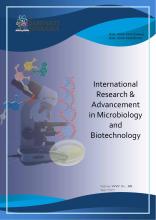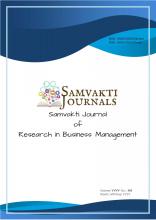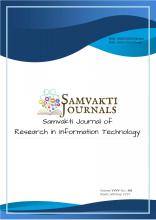+91-9958 726825
An Overview of Smart Home System Based on Internet of Things
|
Intelligent house technology has come a long way been more popular They have become more popular in fresh periods since they increase convenience and excellence of lifetime. Micro-controllers and smartphones are used to operate the vast proportion of intelligent home devices. Using a Wi-Fi connection connection methods To operate and monitor the home, a mobile app is used. operations. By key determining into sensors and devices, making connections Things that are intelligent and use appropriate technologies to facilitate connections with. We investigate the notion of an intelligent house with combination of IoT technologies and cloud computing enabling simple access in multiple places, boosting compute electricity, stored capacity, and enhancing effectiveness of information transmission In this book, we'll look at, we'll look at how a combination of three components may be used to create a solid foundation for an advanced smart home idea and execution. The field of clever gadgets for home automation has grown dramatically in recent years. These devices are designed to make people's interactions with one another and their everyday household chores easier. Although each appliance is easy to operate on its own, each has its unique settings interface, which contributes to the overall user experience. This review paper outlines a method for combining several devices into a single signal entity that may may be accessible at any point in time. The solution combines the capabilities of several combining all of your house monitoring equipment into a dedicated app.
|
|
Home is where each individual's personal and private information may be located, and it represents one of life's most significant investments[1]. It is an important aspect of people's life, and progress in this field implies greater comfort for everyone. People are constantly looking for innovative ways to improve their comfort. This offers suggestions for making everyday chores simpler or perhaps removing some of the responsibilities entirely. People may now install smart gadgets in their houses to manage some of their household chores[2]. This kind of capacity to operate an intelligent gadget remotely eliminates the requirement to be nearby the device. Aside from mundane domestic tasks like changing the colour of the lighting or the heat of the space, house safety is a crucial factor. People naturally desire to preserve it since it may store personal and precious items and papers[3]. Beginning in Ancient Egypt, mechanical door locks have been utilized. The traditional mechanism has been modernized.
However, these new ways of regulating what occurs within the home must be simple to use and comprehend. People need to find methods to simplify their activities, not only adapt them to the contemporary environment. The smart gadgets should be simple to incorporate into the household. The Internet of Things (IoT) has no clear definition (IoT)[4]. Regardless, it is 1 of the best well-known. subjects, with many businesses investing in innovation and study. Simultaneously, an increasing number of linked gadgets are expected to be launched. This had an impact on the IoT growth. Because it is constantly developing and is found in many goods, it is important to comprehend its significance and difficulties. The phrase relates to the act of linking gadgets to the Internet that are not directly managed by people. These gadgets are referred to as "things." By linking these gadgets, a sophisticated and imperceptible network is formed that may be accessible over the internet. In additional to the capabilities that each device provides, the networks must offer an access. gadget has the ability to incorporate [5]. Through that interface, smart devices may be managed and programmed remotely. All IoT devices include inbuilt technology that enables them to interact with one another or with consumers through the Internet[6]. In several areas, intelligent gadgets have been developed. Almost every day, a new IoT-enabled device is announced by a business. Wearables, linked vehicles, smart healthcare, and smart farming are just a few of the most prominent uses. As a result of the Internet of Things, anybody may track their own actions utilizing wearables and smart medical equipment, as well as operate vehicles using linked automotive solutions Another use of the Internet of Things which sticks out as the more active is smart home. According to a 2015 statistics study, more than 60000 individuals search the phrase "smart house" every month, and much greater than 250 businesses and begin put money into it field. The The conventional smart home parts are used in the construction of our proposed enhanced intelligent home combined composite, the IoT, cloud technology, and regulation event analysis are all buzzwords these days. To the recommended configuration, every Its basic functions and technologies are provided by the element[7]. The internet of things (IoT) provides Portable devices featuring a range of senses might be useful. connected to the internet and managed remotely. Detectors may be installed in home equipment for example, airflow conditioner, glows, and additional environment equipment. As a consequence, it combines computers putting intellect into house equipment to enable for home condition measuring and appliances control. performance. The advantages of cloud computing are many. offers scalable processing power, storing space, and apps for creating, managing, and accessing home devices from anywhere at any time. The sophisticated smart home composition is controlled and orchestrated as a result of a regulation occurrence processing system. Combining technologies to create an item that is the greatest of its kind has been discussed in contemporary literature in a number of different methods. Christos combine cloud computing with IoT will be used to show how clouds technology improves IoT possibilities. Majid Al-Kuwari focusses on integrated Internet of Things (IoT) for remotely controlling home appliances in a smart house utilizing processed data. improve machine learning techniques such that they can help secure a smart home environment. Scholars suggest that sensors be used to perceive and give high-accuracy fire detection in real-time. In this chapter, the mix of conventional intelligent house, IoT, and clouds computing is examined. Start by going over the basics of smart homes, the Internet - Of - things, clouds technology, and occasion processing systems. We discuss their compatibility and harmony, as well as whatever motivates them to work together right now. We also go through what platforms and initiatives are currently available for integrating IoT, internet, and intelligent house paradigms. From a connection standpoint, The internet, as much as the home local area network, are connected to the extra IoT devices and the cloud in this situation. These links complete the setup, culminating in an united and integrated systems with greater functionality processing power, sophisticated third-party tools, comprehensive apps, and enough storage. The intelligent housing is a residential version of construction management that allows you to manage and automate all of your home's technology. It relates to a house that is equipped with equipment, illumination, heaters, Security and video systems, air conditioner, televisions, laptops, and entertaining equipment, as well as a large house appliance such as washers/dryers and fridges, and large house equipment such as washers/dryers and fridges that may interact with one others and be managed remotely using a timer, telephone, portable phone, or the web those technologies are formed up of switch and sensing that are linked to a common hubs and managed by the homeowners through a tower command panel display or a handheld gadget attached to the web clouds. A smart house provides Security, fuel economy, minimal running expenses, and relaxation are all factors to consider. Item setup that is intelligent preserves hours, cost, and power while also being convenient[8]. Such systems are adjustable and configurable to keep up with the already environment needs of the residents. Its architecture is adaptable sufficient to work with a variety of gadgets form a variety of vendors and specifications. in most cases. Using micro - controller The fundamental design allows for detectors and controllers. the monitoring of home circumstances, the analysis of interferometric data, as well as the monitoring of house integrated gadgets. The smart house concept is rapidly gaining popularity and penetration, as it has becoming a part of pricing and Aspects in modernisation. That is proficient by including the volume to retain a centralize event log, run machines learning techniques, and give critical cost elements, savings suggestions, and various helpful statistics [9].
A smart house consists of three elements: equipment, programming, and standards for communications It has a broad range of electronic capabilities. consumers. Farming, safety and security, air excellence, and water quality are just a few of the things that come to mind when thinking about lighting. tracking, speech assistant, valves, locks, electricity and water metering are a few examples of house management themes that have led to IoT equipped homes. connections. Sensor, gateway, protocol, software, cloud services, databases, software, and gateways are all part of the Internet of Things are instances of smart home components that are more sophisticated. Platform-as-a-service (PaaS) is one kind of IoT clouds platform. (PaaS) and infrastructural facilities (IaaS) (IaaS). Figure 4 displays the primary elements of the upgraded proposal intelligent house, as well as the interconnections and information flow among them. The house with intelligence app updates the house databases in the cloud, enabling remote clients to access it and get the greatest up-to-date details on the home's status. Encryption and identification of devices, messages brokers and message queues, Devices management, standards, data collecting, visualisation, and analytics, as well as interaction with other systems multiple web servers, flexibility, true APIs, and open access libraries are all accessible. All of these features are incorporated in a standard IoT platform[10]. Heating, luminosity, liquid level, air element, protection video cameras, voice/sound, weight, IoT detectors for house management include moisture, accelerometers, laser, tremors, and ultrasonic detectors. Thermostats are amongst the most often utilized intelligent home sensors; the bulk of them are temperatures sensors. Many of them are digital, whereas others are analog. and might be very realistic. The illumination is measured using lux sensors. Acoustic groundwater pressure sensors IoT programmers may employ floating levels monitors to get highly exact data readings.
Manufacturers employ air component monitors to identify particular conditions CO, hydrogen, and nitrous oxide layers, which are illustrations of airborne components and harmful amounts of gas The majority of them feature a warming phase, which means they must be heated for a certain amount of time before displaying correct data. It detects gas particles on a substrate and only displays data when the region has been adequately heated. Monitoring and analysis are carried out using video cameras. There are a variety of webcams to pick from, all of which have superior connection. The Raspberry Pi CPU is suggested since its display component is very fast and had a straight flexible link to the board. Noise sensors are often utilized to identify, analyze, and respond to noise. Some individuals are able to distinguish among ultra-low audio frequency and fine-tune their hearing. Temperature detectors are used in smart homes to monitor the amount of moisture in the air. The correctness of a detector are influenced by its design and location. When compared to higher sensitivity like the HIH6100, some detection, like as the DHT22, designed for quick prototype, often perform badly. The dispersion surrounding the sensor should be homogeneous in wide regions, allowing less correction steps for proper calibrating. Smart home connection technologies such as Bluetooth, Wi-Fi, and Sms are samples. Bluetooth data safety and wireless lan technology with mesh capability approaches are accessible in intelligent or low-energy versions. Zigbee is a proprietary radio frequency-based Internet-of-Things (IoT) protocol. Powerline cabling is used for signaling and management in the X10 protocols. Both wireless and cable communications are possible with Insteon. Z-wave is a house technology company that prioritizes security. UPB utilizes existing electricity lines. Threads is a royalty-free protocol for intelligent house management. ANT is a technology that uses very little electricity. for creating low-power sensors that may be distributed in a mesh. Threads, Z-wave, Zigbee, or Bluetooth lower frequency are the most popular protocols. Cloud connection, available protocols, customization difficulty, and prototyping support are all factors to consider when integrating a gateway. The phase machines, events buses, services log, and timer are all examples of state machines. are all part of the home control system. Modularity allows the bundle idea, runtime dynamics, the management of software components at runtime, service orientation, and the management of bundle dependencies. That is the applications layer's real operations. services strands: provides a model of interaction among various modules, lifetime cycle layer: regulates the life cycle of the bundle, life cycle layer: regulates the life cycles of the bundles, life cycles layer: regulates the life cycle of the bundles, life cycle layer: regulates the life cycle bundle life cycle layer: bundle life cycle layer: package life cycle layer: bundle life cycle layer: bundle life cycle layer: bundle life cycle layer: bundle life cycle layer: bundle life cycle layer: bundle life cycle layer: bundle life cycle layer: bundle life cycle layer: bundle life, life cycle layer: controls the life cycle of the bundles, life cycle layer: Optional security layer that uses Java 2 security architecture to handle permissions from various modules. OpenHAB is a smart home platform that combines home automation and an IoT gateway. It has the following features: a rules engine, a logging system, and a user interface abstraction. Easy setup, common supported hardware, and automation rules that concentrate on time, mood, or ambiance: Domoticz architecture: Because so few people are aware of Domoticz's architecture, it's very difficult to create with any programs on it incurring needless risks in the product's development. When you consider the idea of a sensor controlling an actuator, for example, the whole basic architectural layout seems a bit strange. OO-based languages may be used to create sophisticated Domoticz applications. The Raspberry Pi may simply be used to deploy blockchain into household networks. Without a major rewrite of the current code base, among endpoints and gateway, a blockchain-secured bridge may be created. Blockchain is a technology that will help to reassure them in the future with Airbnb's variable renting model is an example of an innovative and novel business concept. |
|
The fusion of 3 disparate ideas linked components, smart home, internet of things, as well as clouds computer, was described. To organize and manage the data, we suggest a centralised real-time event analysis application. enormous inflow of knowledge an effective and balanced manner, leveraging the every product's characteristics. We explain the advantages and benefits of each solo component, as well as potential complements that may be obtained by integrating it with other components, resulting in additional advantages of the entire chemical system. Because these components are still in the early stages of development, their integration may evolve, resulting in a stable paradigm that produces infrastructures and uses of a new generations. We will continuously explore more components to be added as we track the development of each component and its effect on the combined mixture, leading in new service models and applications.
|
|
The article offers a working solid evidence for an intelligent house system readily applied to a real-world setting. The paper's tiny home provides a method for creating a security system that may be managed remotely. Aside from that, it combines the functions of two intelligent devices into a single interface for adjusting light settings and room temperature. With the help of a web software and the appropriate access permissions, the application may be accessed from any mobile device. This gives the program more flexibility and makes it easier to interact with it. This project may be utilized by both system engineers and individuals with minimal understanding of technology since the application's interface is simple to comprehend. This paper describes how the smart home mechanism works. The physical components it requires, their connectivity, the application's architecture, and the specifics of achieving the aforementioned functions are all detailed here. There are various home There are a variety of security devices available on the market. include locks for doors and windows, presence sensors, and alarm activation devices. This proof of concept has the benefit of being an open source project that can easily be modified to control components in a real home. Another benefit of this system is the smart gadgets it employs. It unifies the administration of both the thermostat and the light bulb into a single interface. As a result, the user only has to utilize one program to customize their house.
Finally, utilizing the Brillo operating system on an Edison board, this article demonstrates how to link combining many smart gadgets into an unique entity. The proposed concept includes a flexible and expandable design that can simply be modified to accommodate additional appliances and features. This smart home solution's future growth may be focused on additional areas. On the one hand, it may include more sophisticated equipment to accommodate a wider range of household activities. Furthermore, new functionality for the already included devices may be created on the board device. These include creating default scenes and themes that automate smart appliance tasks from the comfort of one's own home depending on the user's preferences. Aside from the functionalities provided by the sensors, the security solution may be incorporated into real goods with additional functionality. Users may manage their home security without the need for security firms to install specialist equipment. |
|
|
Pain Text:
Mr Manoj Kumar Ojha (2021), An Overview of Smart Home System Based on Internet of Things. Samvakti Journal of Research in Information Technology, 2(2) 9 - 17. DoI : 10.46402/2021.02.18
Mr Manoj Kumar Ojha (2021), An Overview of Smart Home System Based on Internet of Things. Samvakti Journal of Research in Information Technology, 2(2) 9 - 17. DoI : 10.46402/2021.02.18




